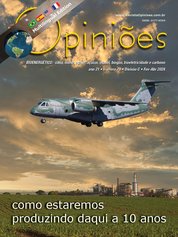Evandro Gussi
CEO of UNICA
OpAA79
SAF: opportunity for Brazil to fly higher and higher
When he was in Brasília, in January 2024, the executive director of the International Energy Agency, Fatih Birol said that Brazil will enter an unprecedented period in its economic and political history. This vision was evident in his words: “Brazil’s time has come. The transmission of clean energy in the world is not happening, but Brazil has the muscles and leadership to drive fair and inclusive development”.
The International Energy Agency's investment in Brazil is extremely relevant and reinforces the country's vocation to lead the transition to low carbon. We already have one of the cleanest energy matrices in the world, with 49% of energy coming from renewable sources.
Ethanol, a clean and renewable biofuel, has been used in road transport for four decades, in a successful experience of diversifying the energy matrix, while reducing greenhouse gas emissions. And we can go further, with effective responses for other sectors with challenging decarbonization goals, such as air transport.
Aviation accounts for 2% of global greenhouse gas emissions, reaching up to 5%, depending on the metric used and the gases considered. It is part of the group of sectors most difficult to decarbonize. The good news is that we have enormous potential here in Brazil to enter the Sustainable Aviation Fuel market.
Sustainable Aviation Fuel is considered the most viable alternative to decarbonize the aviation sector because it can be mixed with fossil aviation kerosene in a proportion of up to 50%. Furthermore, it is a drop-in solution, meaning it can be used with the fuel infrastructure currently in place at airports, fully compatible with modern aircraft.
According to the International Air Transport Association, Sustainable Aviation Fuel could contribute around 65% of the emission reductions needed for aviation to reach net zero by 2050, a target negotiated in 2022 within the scope of the International Civil Aviation Organization, the United Nations.
To date, 11 technologies have been certified by American Society for Testing and Materials, to produce it. One of the most promising routes is Alcohol to Jet, which uses ethanol as a base. And it is at this point that Brazilian experience in the production and use of ethanol as a fuel can play an even more relevant role, accelerating the implementation of the use of biofuels in aviation.
Brazil-Japan:
At the end of 2023, we had the opportunity to promote discussions on this issue at a workshop held in Tokyo, Japan. The Japanese government established a mandate for the use of 10% Sustainable Aviation Fuel in 2030, for international flights at Japanese airports. And it estimates that demand could reach 1.7 billion liters of Sustainable Aviation Fuel per year.
With available raw materials and the possibility of sustainable growth in ethanol productivity, Brazil has great potential to contribute in the coming years to the diversification of energy sources in air transport in Japan and in different geographies around the world, including the domestic market.
We have the technical and operational capacity to enter this market in two ways: either by supplying inputs, such as ethanol from sugar cane and corn, or by developing sustainable fuel for aircraft.
In this sense, Brazilian efforts converge so that this potential is realized. On the one hand, we find public policies designed to leverage the Sustainable Aviation Fuel agenda, such as Fuel of the Future, which creates the National Sustainable Aviation Fuel Program.
If there are robust and well-structured public policies, investors follow the natural market movement, responding to demand. And the Brazilian production sector already has companies well-positioned on the international scene, with certifications for the production of Sustainable Aviation Fuel.
As can be inferred from this movement, the challenges of the environmental agenda bring incredible opportunities to decarbonize, expanding business. Whether on land or in the air, we see a bright future for ethanol.




